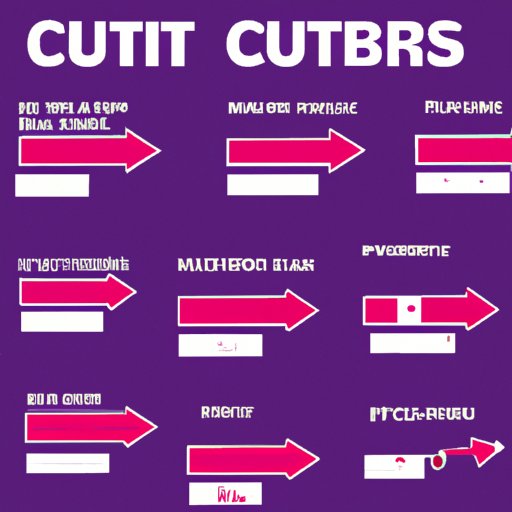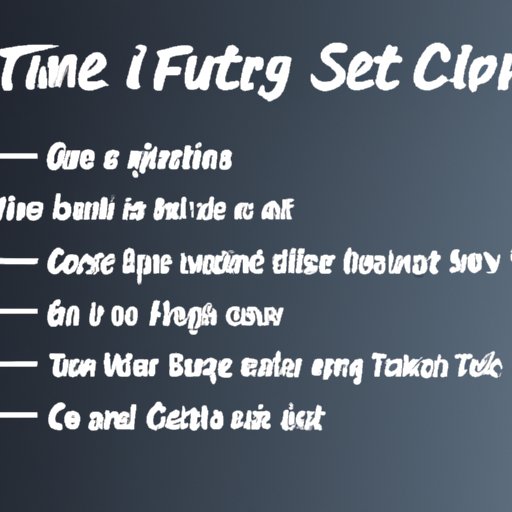Introduction
A cut in fitness is a period of time during which an individual reduces their calorie intake and increases their physical activity level in order to lose weight and/or build muscle. During this process, individuals focus on eating healthy foods and exercising regularly in order to reach their desired goals. While there are many benefits to cutting weight and building muscle with a fitness cut, there are also some drawbacks that should be taken into consideration before beginning a cut.
A Guide to Cutting Weight and Building Muscle with a Fitness Cut
If you’re considering taking on a fitness cut, the first step is to understand your goals. Are you looking to lose weight, build muscle, or both? Once you’ve determined what you want to achieve, you can begin to create a plan to get there.
Understanding Your Goals
Before you start a cut in fitness, it’s important to have realistic expectations. While it’s possible to lose a significant amount of weight in a short period of time, it’s not necessarily healthy or sustainable. Similarly, if your goal is to build muscle, it’s important to understand that it takes time and commitment to see results.
Setting a Calorie Deficit
The key to successful weight loss is to create a calorie deficit, which means you’re consuming fewer calories than you’re burning. A good starting point is to reduce your daily calorie intake by 500-1000 calories, depending on your current weight and activity level. It’s also important to ensure you’re getting enough nutrients from food sources, so make sure to include plenty of lean proteins, fruits, and vegetables in your diet.
Incorporating Exercise into Your Cut
Exercise is an important part of any fitness cut. Not only does it help you burn more calories, but it also helps you build muscle, which can speed up your metabolism and help you maintain your weight loss. Aim to exercise at least 3-5 times a week and incorporate both strength training and cardio into your routine.

How to Achieve Your Goals with a Fitness Cut
Once you’ve established your goals and created a calorie deficit, it’s time to put together a plan for success. Here are a few tips to help you stay on track.
Creating a Meal Plan
Creating a meal plan is one of the best ways to stay on track with your fitness cut. Planning out your meals ahead of time will help you stick to your calorie deficit and ensure you’re getting all the necessary nutrients. Aim to eat three meals and two snacks a day and try to include a variety of healthy foods in your diet.
Adding Supplements to the Diet
Adding supplements to your diet can be beneficial when you’re cutting weight and building muscle. Protein powders and pre-workout supplements can help boost energy levels and increase muscle growth. However, it’s important to remember that supplements are not necessary for success and should only be used in addition to a healthy diet and exercise program.
Managing Stress and Sticking to the Plan
Making lifestyle changes can be stressful, so it’s important to find ways to manage stress and stay motivated. Exercise, meditation, and spending time with friends and family can help relieve stress and keep you on track with your fitness cut. Additionally, setting small, achievable goals can help you stay committed and celebrate your progress along the way.

Understanding the Different Types of Cuts in Fitness
There are several different types of cuts in fitness, each with its own set of benefits and drawbacks. Here’s a brief overview of the most popular types of cuts.
Low-Carb vs. High-Carb Diets
Low-carb diets, such as the ketogenic diet, involve reducing carbohydrates and increasing fat intake in order to induce a state of ketosis, which is when the body starts burning fat for energy. High-carb diets, on the other hand, involve increasing carbohydrates and decreasing fat intake in order to fuel the body with energy. Both types of diets can be effective for weight loss, but it’s important to choose the right one for your goals and lifestyle.
Intermittent Fasting
Intermittent fasting involves alternating periods of eating and fasting in order to reduce calorie intake and promote weight loss. There are several different methods of intermittent fasting, including the 16/8 method, where individuals fast for 16 hours and eat within an 8-hour window, and the 5:2 method, where individuals eat normally for five days and fast for two non-consecutive days. Intermittent fasting can be an effective way to lose weight, but it’s important to speak to a doctor before starting a fasting plan.
Carb Cycling
Carb cycling involves alternating between high-carb and low-carb days in order to maximize fat loss and muscle gain. On high-carb days, individuals consume more carbohydrates in order to replenish glycogen stores and fuel intense workouts. On low-carb days, individuals reduce their carbohydrate intake in order to burn more fat. Carb cycling can be an effective way to reach your goals, but it’s important to speak to a nutritionist or doctor before starting a carb cycling plan.

What to Expect When You Start a Fitness Cut
When you start a cut in fitness, you can expect to see some changes in body composition. As you reduce your calorie intake and increase your physical activity, you’ll likely lose weight and, depending on your goals, you may also gain muscle. Additionally, as you adjust to the lifestyle changes, you may experience cravings, fatigue, and difficulty sticking to the plan.
Changes in Body Composition
When you start a cut in fitness, you can expect to see some changes in body composition. As you reduce your calorie intake and increase your physical activity, you’ll likely lose weight and, depending on your goals, you may also gain muscle. Additionally, as you adjust to the lifestyle changes, you may experience cravings, fatigue, and difficulty sticking to the plan.
Challenges Along the Way
Making lifestyle changes can be challenging, so it’s important to be prepared for any bumps along the way. Cravings, fatigue, and lack of motivation are all common challenges that come with a fitness cut, but they can be managed with proper planning and support. Additionally, it’s important to remember that progress takes time and that it’s normal to experience setbacks.
Tips to Help You Stick With It
Sticking with a fitness cut can be difficult, but there are a few things you can do to help yourself stay on track. First, set achievable goals and reward yourself when you reach them. Second, enlist the help of a friend or family member to keep you accountable. Finally, don’t be afraid to ask for help if you need it.
Conclusion
A cut in fitness can be an effective way to lose weight and/or build muscle, but it’s important to understand what it entails and how to achieve your goals. It’s also important to remember that progress takes time and that there will be challenges along the way. With dedication and commitment, however, you can reach your goals and enjoy the benefits of a cut in fitness.
(Note: Is this article not meeting your expectations? Do you have knowledge or insights to share? Unlock new opportunities and expand your reach by joining our authors team. Click Registration to join us and share your expertise with our readers.)
